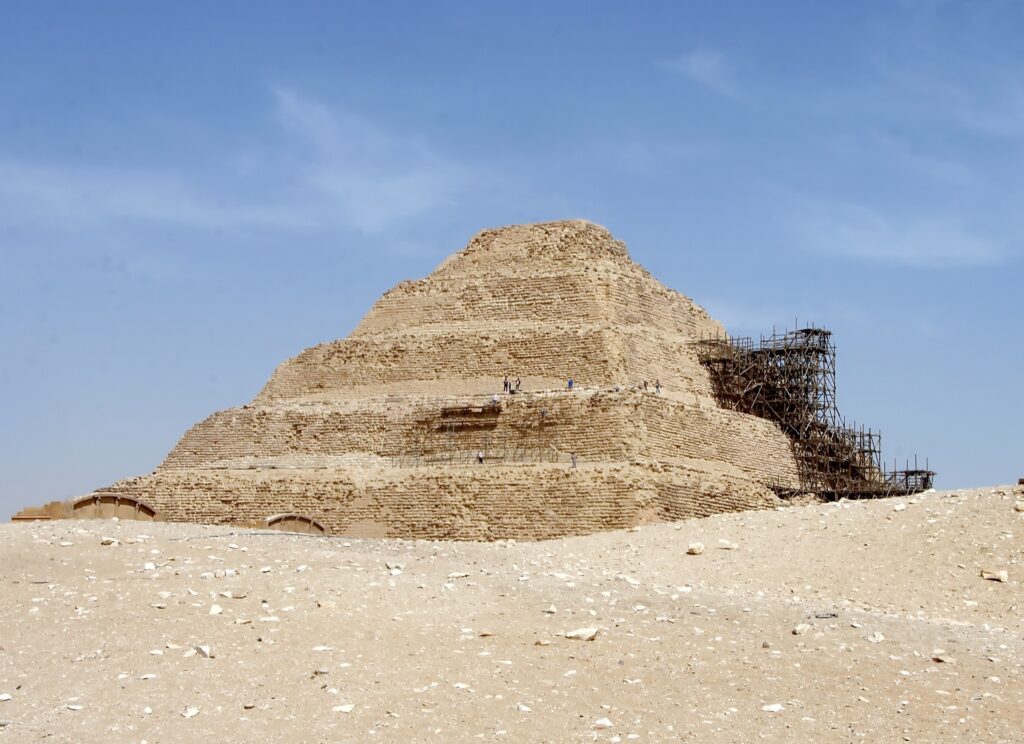Introduction
The ancient Egyptians are one of the most well known ancient civilizations. They developed and thrived along the Nile River in North Africa for thousands of years. Today we will cover some major topics about early Egyptians, leading up to the development of early Egyptian civilization around 3100BCE.
Origins and Culture
The Stone Age in Egypt began around 700,000 years ago when our early ancestors migrated into the region. Yet, it was not until around 5000 BC that the Nile Valley began to attract human settlements. The early settlers lived a more nomadic life, relying on hunting and gathering for their food.
These early Egyptians get divided into two main time periods, the Paleolithic era and the Neolithic era. The Paleolithic era spanned from around 5000 BC to 3500 BC, right before the emergence of Egyptian civilization. We characterize this time by the use of stone tools, including hand axes and choppers. The Neolithic era, which began around 3500 BC and ended with the emergence of the Egyptian Kingdoms. The era saw rapid development of many technologies including irrigation and pottery.
Technology
Stone Age Egyptians skillfully made tools and weapons from stone, bone, and wood. They used flint and other hard stones to create knives, scrapers, and arrowheads. They also made fishing nets and traps from plant fibers and animal sinew.
As the Stone Age progressed, Egyptians developed more sophisticated tools and technologies. They invented the bow and arrow, which greatly improved their hunting and defense capabilities. They also learned how to make pottery, which allowed them to store food and water for longer periods.
Stone tools were the most common form of technology used by the Stone Age Egyptians. The earliest stone tools were crude and simple, made by knapping, or chipping flakes off larger stones to create sharp edges. These tools were used for cutting, scraping, and other basic tasks.
As the Stone Age progressed, the Egyptians began to develop more advanced stone tools, such as hand axes, cleavers, and arrowheads. Flint could be shaped into sharp edges that were ideal for cutting and scraping. This made flint a highly valuable resource during the time.
In addition to stone tools, the early Egyptians also used bone and wood to create a variety of implements. For example, they fashioned bone needles for sewing and carving wooden spears for hunting and defense.
One of the most significant technological advancements of the Stone Age was the development of agriculture. Around 5000 BCE, the Egyptians began to cultivate crops such as wheat, barley, and flax. The Nile River flooded regularly and aided with the cultivation of these crops. This allowed early humans to establish settlements along the river, moving away from a nomadic living.
The domestication of animals was another major technological development during the Stone Age. Animal Husbandry. The Egyptians began to keep and breed animals such as cattle, sheep, and goats. This furthered early Egyptians ability to live in settlements. These animals provided them with meat, milk, and other valuable resources.
The transition from the Stone Age to the Bronze Age brought even more significant technological advancements. The Egyptians began to work with metal, particularly copper and bronze. This practice originiated in the Balkans. The development of metallurgy allowed them to create more durable and sophisticated tools and weapons. Perhaps the most famous development in the region was the wheel. The wheel revolutionized transportation and allowed for the development of complex trade networks.
Religious Beliefs
The Stone Age Egyptians had a rich and complex religious system, although little is known about their beliefs and practices. Archaeological evidence suggests that they believed in animism, the belief that all things had a spirit or soul. We will discuss animism in more detail in a later post.
Early Egyptians may have practiced some for of ancestor worship. This is do to the depiction of animals and humans found in many archeological sites. They also likely believed in a variety of deities associated with nature, like the stars and sun.
Notable Discoveries
At the border of Northern Sudan and Egypt lays an extremely rare archeological find. The Gebel Sahaba site in northern Sudan. This site if famous and it contains one of the earliest findings of human conflict. The site, dated around 13,000 years ago, contains the remains of a of a 25-year-old woman who die from a stone projectile. This makes her one of the earliest known victims of human warfare.
Another major discovery is at a site in Fayum region in Egypt. Dated around 5000 BC, this stone age settlement contains a granary and brewery. Additionally, archeologists found stone drawings of animals such as giraffes, elephants, and hippos. The art also depicts, human figures engaged in various activities such as hunting, dancing, and farming. During the Bronze age, this region would grow to include many settlements and the city of Crocodilopolis.
Another major sit is the Merimde Beni Salama site. It is one of the earliest and most important prehistoric sites in Egypt. It is located in the Nile Delta region and was first excavated by French archaeologist Jean-Phillipe Lauer in the 1930s. The site contains evidence of human occupation dating back to around 20,000 BCE. The site contains evidence of the transition from hunting and gathering to agriculture.
One of the most significant finds at the Merimde Beni Salama site is a large collection of artifacts and evidence. The site includes stone tools like blades, scrapers and arrowheads. Additionally, it contains evidence of early agriculture, including the cultivation of wheat and barley. We know this by the discovery of tools such as sickles and stone grinders. This site also contains evidence of the domestication of animals such as cattle, sheep, and goats. We have discovered bones that contains diseases associated with captivity. Besides, the site has yielded some artifacts, including pottery vessels and figurines. These artifacts provide valuable insight into the daily lives and cultural practices. The excavations at the Merimde Beni Salama site have played a crucial role in our understanding of the origins and development of early human societies in Egypt.
Transition to the Bronze Age
The transition from the Stone Age to the Bronze Age was a significant period of change for the Egyptians. The Bronze Age began in Egypt around 3200 BC and saw the development of new technologies, such as the use of bronze for tools and weapons. This period also saw the rise of complex societies and the emergence of early forms of writing.
Perhaps the second most symbolic depiction of Egyptians is their writing system. The early Egyptians developed a system of writing known as hieroglyphics. The Egyptians used them for both religious and administrative purposes. Additionally, this transition sees Egyptians taking large leap in engineering and architecture. They also constructed monumental structures such as the Step Pyramid of Djoser. Which display the prowess in building that we are more familiar with.

Conclusion
The early Egyptians played an important role in shaping the the region. Their developments would lay the ground work for one of the most famous Bronze Age civilizations. Their transitions nomadic hunters and gatherers to their development of settlements, proved these early Egyptians were innovative and resourceful. Their tools, weapons, and artwork provide insight into their way of life.
The transition to the Bronze Age saw the emergence of complex society. This organization enabled the Egyptian Kingdoms to develop and rapidly grow. The early Egyptians advancements in writing, architecture and engineering, laid the foundation for the Egyptian Kingdoms. These remarkable civilization would come to dominate the region for thousands of years.
The Stone Age Egyptians get overshadowed by their more well-known successors, their contributions to human history can not be understated. By studying their culture, technology, and religious beliefs, we can gain a deeper understanding of the rich and diverse history of the ancient world.
Deeper Reading:
- “Before the Pyramids: The Origins of Egyptian Civilization” by Emily Teeter
- “Egypt Before the Pharaohs: The Prehistoric Foundations of Egyptian Civilization” by Michael A. Hoffman
- “Ancient Egypt: Anatomy of a Civilization” by Barry J. Kemp
- “The Dawn of Egyptian Art” by Diana Craig Patch
- “The First Civilizations: The Archaeology of Their Origins” by Glyn Daniel

2 comments
[…] and resilience of the early inhabitants of the Americas. While other civilizations such as the Egyptians were sprouting out of the Nile, the Norte Chico was forging its own […]
[…] and resilience of the early inhabitants of the Americas. While other civilizations such as the Egyptians were sprouting out of the Nile, the Norte Chico was forging its own […]